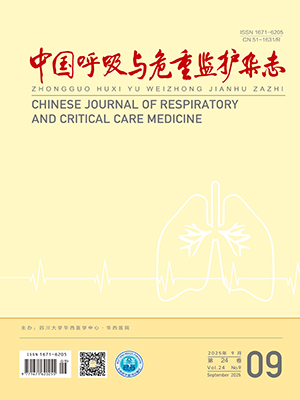| 1. |
Zein H, Baratloo A, Negida A, et al. Ventilator weaning and spontaneous breathing trials: an educational review. Emergency (Tehran), 2016, 4(2): 65-71.
|
| 2. |
Demoule A, Jung B, Prodanovic H, et al. Diaphragm dysfunction on admission to the intensive care unit. Prevalence, risk factors, and prognostic impact-a prospective study. Am J Respir Crit Care Med, 2013, 188(2): 213-219.
|
| 3. |
Harper CJ, Shahgholi L, Cieslak K, et al. Variability in diaphragm motion during normal breathing, assessed with B-mode ultrasound. J Orthop Sports Phys Ther, 2013, 43(12): 927-931.
|
| 4. |
窦志敏, 李红, 朱磊, 等. 膈肌浅快呼吸指数对机械通气慢性阻塞性肺疾病患者撤机的预测价值. 中国呼吸与危重监护杂志, 2017, 16(2): 124-127.
|
| 5. |
Doorduin J, van Hees HW, vander Hoeven JG, et al. Monitoring of the respiratory muscles in the critically ill. Am J Respir Crit Care Med, 2013, 187(1): 20-27.
|
| 6. |
杨旻, 李惠, 尹璐, 等. 床旁肺部超声在重症患者机械通气脱机评估中的应用价值. 中国急救医学, 2017, 37(11): 1000-1004.
|
| 7. |
刘英芹, 卢广民, 刘耿熙, 等. 膈肌活动度超声检测、血清 NT-proBNP 及被动抬腿试验容量反应性对机械通气患者困难撤机的预测价值. 山东医学高等专科学校学报, 2016, 38(6): 417-420.
|
| 8. |
胡仕静, 周树生, 吴丹, 等. 膈肌超声预测机械通气撤机结果的价值. 安徽医科大学学报, 2016, 51(5): 673-677.
|
| 9. |
Goligher EC, Laghi F, Detsky ME, et al. Measuring diaphragm thickness with ultrasound in mechanically ventilated patients: feasibility, reproducibility and validity. Intensive Care Med, 2015, 41(4): 642-649.
|
| 10. |
Golisher EC, Fan E, Herridge MS, et al. Evolution of diaphragm thickness during mechanical ventilation. Impact of inspiratory effort. Am J Respir Crit Care Med, 2015, 192(9): 1080-1088.
|
| 11. |
Schepens T, Verbrugghe W, Dams K, et al. The course of diaphragm atrophy in ventilated patients assessed with ultrasound: a longitudinal cohort study. Crit Care, 2015, 19: 422.
|
| 12. |
Boon AJ, Sekiguchi H, Harper CJ, et al. Sensitivity and specificity of diagnostic ultrasound in the diagnosis of phrenic neuropathy. Neurology, 2014, 83(14): 1264-1270.
|
| 13. |
Ferrari G, De Filippi G, Elia F, et al. Diaphragm ultrasound as a new index of discontinuation from mechanical ventilation. Crit Ultrasound J, 2014, 6(1): 8.
|
| 14. |
孙强, 山峰, 董海, 等. 超声膈肌增厚率对重症肌无力危象机械通气患者撤机成功的预测价值. 中华危重病急救医学, 2017, 9(7): 619-623.
|
| 15. |
张海翔, 龚仕金, 宋佳, 等. 膈肌超声指标对机械通气患者撤机结果的预测价值研究. 浙江医学, 2018, 9(5): 919-923.
|
| 16. |
宋洁琼, 钟鸣. 膈肌超声在危重症中的临床应用. 中华诊断学电子杂志, 2018, 6(2): 95-97.
|
| 17. |
Zambon M, Greco M, Bocchino S, et al. Assessment of diaphragmatic dysfunction in the critically ill patient with ultrasound: a systematic review. Intensive Care Med, 2017, 43(1): 29-38.
|
| 18. |
陆志华, 徐秋萍, 袁月华, 等. 膈肌增厚分数指导慢性阻塞性肺疾病机械通气患者撤机的临床研究. 中华急诊医学杂志, 2016, 25(4): 491-494.
|
| 19. |
龚仕金, 宋佳, 张海翔. 重症超声: 脱机过程中一种有用的评估工具. 浙江医学, 2017, 39(3): 149-151.
|
| 20. |
Farghaly S, Hasan AA. Diaphragm ultrasound as a new method to predict extubation outcome in mechanically ventilated patients. Aust Crit Care, 2017, 30(1): 37-43.
|
| 21. |
Matamis D, Soilemezi E, Tsagourias M, et al. Sonographic evaluation of the diaphragm in critically ill patients. Technique and clinical applications. Intensive Care Med, 2013, 39(5): 801-810.
|
| 22. |
刘岷, 骈林萍. 超声评价膈肌活动度与慢性阻塞性肺疾病患者生活质量及运动能力的相关性研究. 中国呼吸与危重监护杂志, 2018, 17(6): 548-551.
|




